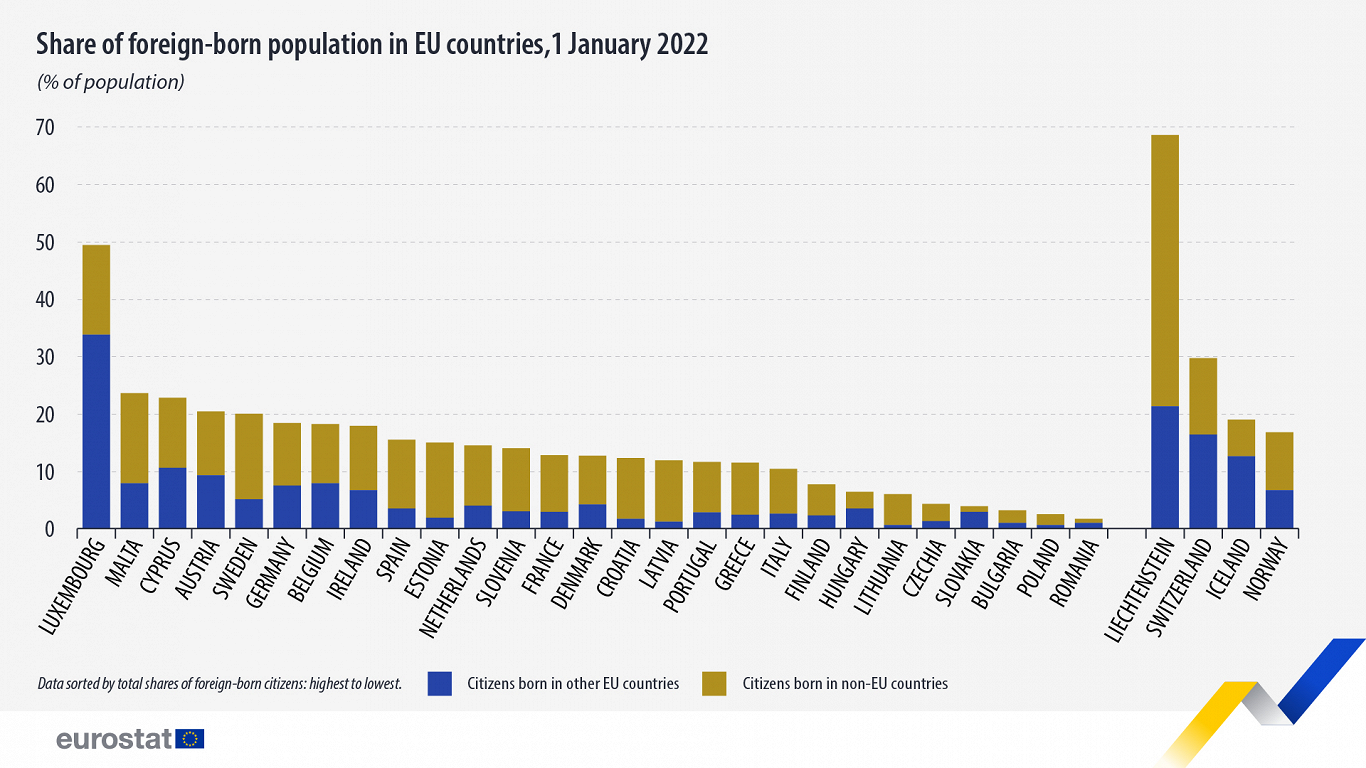This information comes from data on migrant and migrant population published by Eurostat March 29.
Latvia's rate of immigration was fairly low at 6.7 immigrants per 1,000 people. There were 12,689 immigrants in total. The figure was up on the 2020 figure of 8,840. Around half of Latvia's immigrants during the year were Latvian nationals, i.e. so-called 'remigrants' returning home from abroad. 5.5% were immigrants from other EU countries, 45.1% were from non-EU countries and 0.1% were stateless.

In 2021, there were an estimated 2.3 million immigrants coming to the EU from non-EU countries and about 1.1 million people from the EU who emigrated to a country outside the EU.
Data show an important increase compared with 2020 when an estimated 1.9 million immigrants to the EU from non-EU countries and about 956 thousand people emigrated from the EU to a country outside the EU. In addition, 1.4 million people previously residing in one EU country migrated to another EU member in 2021 (1.2 million in 2020).
Foreign-born population
On 1 January 2022, almost half (49.4%) of the population in Luxembourg was foreign-born. This EU country was followed by Malta (23.6%) and Cyprus (22.7%) as the EU members with the highest shares of foreign-born population. In contrast, the lowest shares were recorded in Romania (1.7%), Poland (2.5%) and Bulgaria (3.2%).
In absolute terms, the biggest populations of foreign-born citizens (from other EU members and non-EU countries) were registered in Germany (15.3 million people), France (8.7 million) and Spain (7.4 million).
In relative terms, Luxembourg had by far the biggest community of citizens born in another EU country, 33.8%, followed by Cyprus with 10.6% and Austria with 9.3%. Belgium and Malta also registered high shares of citizens born in other EU countries, with 7.9% each.
Poland and Lithuania, on the other hand, had the smallest shares of citizens born in other EU countries, with only 0.6% each. Bulgaria and Romania also recorded low values, with 1.0% each.

When it comes to citizens born in non-EU countries, the highest shares were recorded in Malta (15.7%), closely followed by Luxembourg (15.6%). These two EU members were followed by Sweden (14.9%), Estonia (13.1%) and Cyprus (12.2%). Registering the lowest shares of non-EU-born citizens were Romania (0.7%), Slovakia (1.0%), Poland (1.9%), Bulgaria (2.2%) and Hungary (2.9%).
Compared with 2021 (in absolute terms), 13 EU members saw the number of citizens born in non-EU countries and in EU countries both increase in 2022 (Belgium, Bulgaria, Denmark, Estonia, Ireland, Luxembourg, Hungary, Malta, Netherlands, Austria, Slovakia, Finland and Sweden), while five members saw the opposite trend with the number of both those groups of citizens decreasing (Czechia, Greece, Italy, Latvia and Romania).
Some other interesting trends were observed: in Germany, France, Spain, Cyprus, Lithuania, Poland and Slovenia, the number of non-EU-born citizens increased while the number of citizens born in other EU countries decreased. The opposite was registered in Croatia (to a very small degree) and Portugal, where the number of citizens born in other EU countries increased, but the non-EU foreign-born population decreased.
On the matter of the resident non-national population in EU member states, Eurostat picked out the pearticular circumstances in Latvia, saying: "In most EU Member States, the majority of non-nationals were citizens of non-EU countries. Only in Luxembourg, Cyprus, Austria, Ireland, Belgium, the Netherlands and Slovakia did citizens of another EU Member State make more than 50 %. In the case of Latvia, the proportion of citizens from non-member countries is particularly large due to the high number of recognised non-citizens (mainly former Soviet Union citizens, who are permanently resident in these countries but have not acquired any other citizenship)."






























